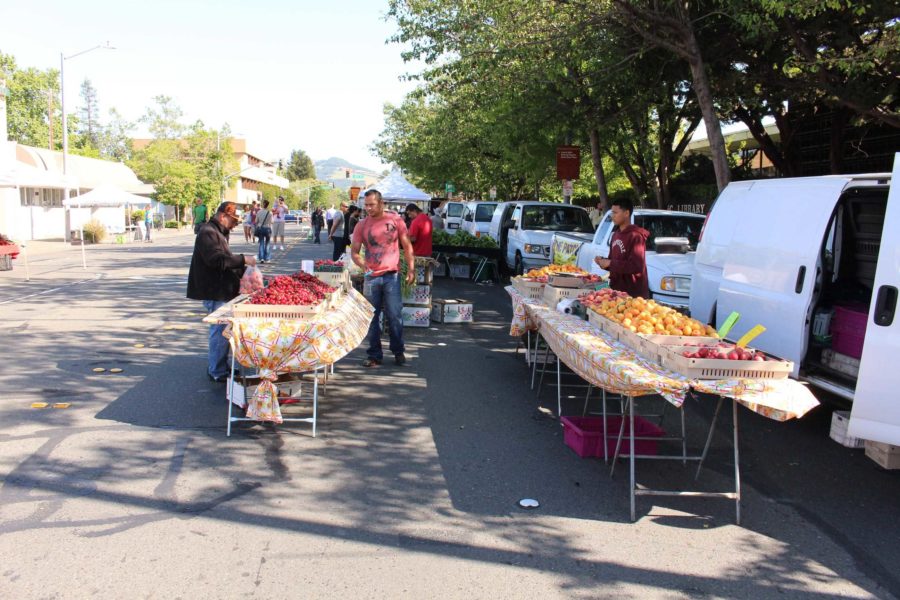Hunger is not simply discomfort in the bellies of students. The effects of hunger ripple through many aspects of a student’s life. Jora Methvin is a humanities student at Santa Rosa Junior College. She works part time as a waitress to afford her expenses, including rent, bills and school. “I have been too broke to buy food and many days resorted to racking up a tab at work and church donations before I got approved for food stamps,” Methvin said.
Finding a balance between scholarly success and making enough money to live is a real struggle. Not only does the student’s morale suffer, but grades are often affected as well. “The constant fear of not being able to eat, pay rent or fix my car heavily impacted the way I was able to be present with school work, “ she said.
The stress left Methvin putting off school projects until the last day and staying up until 5 a.m. working. “The extra stress of being poor puts strain on the ability to perform in school. Sleep is missed, meals are given up and my best is almost never available,” she said.
This story is common among college students. Between tuition rates rising, rent spikes, unpredictable gas prices, the cost of living for a student is going up. Students are having to choose between school-related expenses and basic nutrition. Often times a healthy diet is not the top priority. As a result, their productivity and health are taking the hit. Many different resources and organizations in Sonoma County aid in the fight against student hunger, on campus and off. Armed with the proper tools and the right planning, every student should be able to enjoy nutritious meals.
Grocery shopping can be a daunting experience for students on a budget. Some stores are considerably more wallet friendly than others, and there are certain tips and tricks to getting the most bang for your buck.
The best way get fresh delicious produce is at the local farmers market. According to the United States Department of Agriculture, California is the highest-producing agricultural state in America. Sonoma County is wealthy in farms. During the spring and summer, farmers put the fruits of their labors on colorful display at local farmer’s markets. You can take your pick of the four markets in Santa Rosa. On a Wednesday you can go to the Veteran’s building in the morning, then to Fourth Street in the evening, Saturday to the Wells Fargo Center or on Sunday cruise over to the West End Market. You can do price comparisons right there checking out different booths.
Vendors are usually happy to give tips on what’s in season and how to prepare it. Some are even open to haggling. Always be respectful of your local farmers. Growing good food for the tables of the community is their livelihood.
More than just a food source, farmers markets are a source for community and conversation. If you’re fortunate enough to have space to grow in, home gardens are a great way to save money. Growers at your local farmers market are usually happy to talk about their trade. Produce vendors will often have starts for sale and lots of information about cultivating and harvesting. Most vendors return to market weekly or bi-weekly and are a great source for troubleshooting throughout the garden experiment.
Trader Joe’s is an excellent option for budget grocery shopping for the rest of the days of the week. It offers exotic fruits and pre-prepared or frozen products. TJ’s even offers organic food at extremely reasonable rates with average price mark ups of 10 to 40 cents. Trader Joe’s publishes a monthly updated catalog titled “The Fearless Flyer.” This quaint compendium of in-products can help you plan meals in advance and make your shopping experience to be swift and direct. Time is money, after all.
Another great place to get groceries without breaking the bank is Grocery Outlet. Aptly dubbed the “Bargain Market,” it is a discounted grocery store chain that’s been operating for more than 50 years. The chain has relationships with brand-name companies that offer both organic and conventional products. Grocery Outlet buys many of its products at discounted wholesale prices due to packaging changes, product overruns and surplus inventories at the source. The store passes these savings on to the savvy shopper at a discounted rate sometimes as high as 60 percent. Price tags show the comparison between the bargain price and what other stores are asking for the same product, so you can see just how much you’re saving on each item. When you check out, the cashier gives you the total amount saved as well as the amount spent.
Hungry students greatest ally is budgeting. Infinite tips and tools can be found on the internet about budgeting and money saving. Downloading a spending tracker app onto your phone is a great way to take money management into your own hands. Free apps such as Mint.com connect safely to your bank account and categorize your bank card purchases into intuitive categories. Cash purchases need to be manually entered. Once you see how much you’re spending and on what, you can begin to set goals and limits.
For the times where there’s simply not enough money to shop for food, there are still options for the hungry student.
Free food is available at a student-run food pantry here at SRJC. Initiated by the Phi Theta Kappa Club, the pantry had humble beginnings as a pop-up in 2013. With the help of active member and JC student Eli Egger and others, by 2014 the pantry had graduated to an abandoned kiosk at the Barnett building, right next to the vending machines where it is currently located. From the kiosk, the PTK distributes 1,500 to 2,000 pounds of groceries a week including a variety of fruits and vegetables, bread and some frozen foods.
“With very little advertising, everything still goes, in about a six-hour window,” Egger said. The pantry distributes 9 a.m. to noon on Wednesdays and 10 a.m. to 1 on Thursdays. Sometimes food makes it to Petaluma campus. All of the food is purchased from Redwood Empire Food Bank. The Phi Theta Kappa club raises the funds to operate the food bank, and volunteers do all the distribution.
As a volunteer for the food pantry and a student himself, Egger identifies with the struggle many students face.
“If you’re going to community college it is a very high probability that you’re doing it because it is less expensive than a four-year school… most likely if you’re here you’re giving up work,” he said.
Egger also serves as the chief financial officer for the Student Government Assembly. As a chair on the SGA Budget Committee, he advocates for the SGA to invest more funds the food pantry to help expand the program. He’s aiming for four days a week next semester.
Any student struggling to obtain food in Santa Rosa and Sonoma County can gain access to free food through several organizations working against hunger in the area. Redwood Empire Food Bank has information about its programs at www.refbo.org. It is especially dedicated to ensuring food for kids. F.I.S.H. Food Pantry of Santa Rosa offers a well-rounded bag of groceries once a month to anyone in need. The amount of food varies on how big the household is. The only requirment for pickup is a phone call.
Because Santa Rosa is such an abundant place, it’s hard to imagine that there’s a hunger problem. Between stigma and shame, many hide the fact that they have to skip meals to pay rent or buy books. “The older generation is extremely out of touch with the cost of school and how the low minimum wage isn’t enough to take care of a single person. I think that people aren’t aware of student hunger because they look down on our generation as being lazy, self centered and entitled,” Methvin said.
To those who endure food insecurity, every little bit helps. The trick to staying fed on a shoestring budget is to get creative: starting a community garden, planning meals, going to the professionals for inspiration and advice, keeping an eye out for coupons. It’s important to remember that there are always options and there are people and organizations that are there to help.




